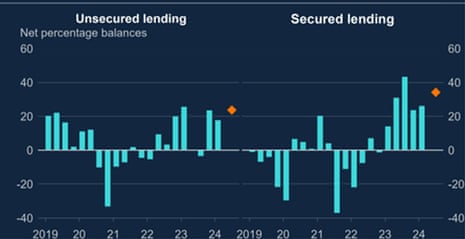Market expectations for the first fully priced-in 25 bps interest rate cut from the Bank of England shift from August to September.
— Andy Bruce (@BruceReuters) April 11, 2024
More ripples from yesterday's hot U.S. CPI print. pic.twitter.com/QQ2MQAp19Q
ECB leaves eurozone interest rates on hold but hints at cut this summer – as it happened
European Central Bank says rate cuts would be appropriate if inflation keeps falling, as BoE policymaker Megan Greene argues UK rate cuts are a way off
Thu 11 Apr 2024 11.02 EDT
First published on Thu 11 Apr 2024 02.34 EDT- Closing post
- Central banks must resist pressure for early rate cuts, says IMF head
- Lagarde: Not being triumphant, but inflation is declining
- The ECB is a “bank of all seasons”, says Lagarde
- Lagarde Q&A: Extra data will help make decision in June
- Lagarde: Eonomy has been weak, but rising real incomes will help
- Lagarde press conference begins
- ING: ECB officially opens the door to a June rate cut
- ECB signals interest rate cut coming
- ECB leaves interest rates on hold
- UK's help for farmers with flooded fields "simply doesn't work"
- Bond markets react to expectation of fewer rate cuts
- UK lenders expect default rates to rise
- UK house prices seen returning to growth
- Self-storage giant Shurgard to buy UK’s Lok’nStore for £378m
- AstraZeneca hikes dividend ahead of CEO pay vote
- UK seen cutting rates earlier than the US
- Bank of England's Greene: rate cuts in the UK should still be a way off
- Introduction: Markets slash bets on rate cuts after US inflation rises to 3.5%

Live feed
- Closing post
- Central banks must resist pressure for early rate cuts, says IMF head
- Lagarde: Not being triumphant, but inflation is declining
- The ECB is a “bank of all seasons”, says Lagarde
- Lagarde Q&A: Extra data will help make decision in June
- Lagarde: Eonomy has been weak, but rising real incomes will help
- Lagarde press conference begins
- ING: ECB officially opens the door to a June rate cut
- ECB signals interest rate cut coming
- ECB leaves interest rates on hold
- UK's help for farmers with flooded fields "simply doesn't work"
- Bond markets react to expectation of fewer rate cuts
- UK lenders expect default rates to rise
- UK house prices seen returning to growth
- Self-storage giant Shurgard to buy UK’s Lok’nStore for £378m
- AstraZeneca hikes dividend ahead of CEO pay vote
- UK seen cutting rates earlier than the US
- Bank of England's Greene: rate cuts in the UK should still be a way off
- Introduction: Markets slash bets on rate cuts after US inflation rises to 3.5%
City traders are no longer fully pricing in the first UK interest rate cut in August and now expect borrowing costs to begin to fall in either that month or September, the Financial Times reports.
That suggests investors are repricing expectations for rate cuts after reading Megan Greene this morning.
The FT adds:
The two cuts they now expect for this year — one in which Prime Minister Rishi Sunak is hoping to deliver an election-winning economic turnaround — contrast with the more than six cuts markets anticipated in January.
The chart in this post shows why Megan Greene is concerned that UK services inflation is running hotter than in the US:
Inflation persistence is a greater threat for the UK than the US — and rates cuts are a way off. Markets must stop comparing the two countries. https://t.co/A6gSwOX1hy pic.twitter.com/p3aWWe2qSr
— Financial Times (@FT) April 11, 2024
Bond markets react to expectation of fewer rate cuts
Back in the financial markets, UK government bond prices are weakening as investors brace for interest rates to remain higher for longer than hoped.
The yield, or interest rate, on UK 10-year government debt has risen by eight basis points (or 0.08 percentage points) this morning, to 4.21% from 4.13% last night.
Yields rise when prices fall, and show that bond traders want a higher rate of return for holding government debt, following the higher-than-forecast inflation rate in the US.
The shorter-dated, two-year UK bonds have also weakened, pushing up their yield by 6 basis points to 4.41%.
American Treasury bonds weakened yesterday, after US inflation rose faster than expected to 3.5% for March.
That shows that bond traders are dialling back their interest rate cut forecasts.
Bond traders are readying for 10-year US Treasury yields surpassing 5% as the scenario of no rate cuts by the Fed this year looks increasingly possible https://t.co/8Gc81ew9Sz
— Bloomberg Economics (@economics) April 11, 2024
Hal Cook, senior investment analyst at Hargreaves Lansdown, says:
“Markets are now pricing in just one or two rate cuts in the US this year - behind Fed projections from March. Reminder: Markets were pricing in six or seven at the start of the year. This shift hasn’t done much damage to equities in recent months, and it still looks like the hope of cuts coming at some point is enough to keep bulls happy.
The primary cause of the shift in expectations has been continued sticky price and wage inflation, both remaining higher than expected in the US. This makes it less likely that the Fed will cut soon, as was expected at the start of the year.
Here’s the state of play this morning, from Reuters’ Andy Bruce:
UK economy round-up:
— Andy Bruce (@BruceReuters) April 11, 2024
🏦 BoE's Greene: rate cuts should be a way off - FT
🏠 RICS survey shows further recovery in housing market activity
💸 Lenders see mortgage supply and demand picking up, but also default rates - BoE survey
📊 Investors push back BoE rate cut expectations
The total number of online jobs being advertised in the UK has dipped, suggesting some cooling in the labour market.
The latest realtime UK economic data shows that online job ads fell 1% last week, and was 19% below the level recorded a year ago.
Figures from @Adzuna show the total number of online job adverts on 5 April 2024 decreased by 1% when compared with the previous week 💻
— Office for National Statistics (ONS) (@ONS) April 11, 2024
This was 19% below the level seen in the equivalent period of 2023.
➡️ https://t.co/UQ77WZfV6u pic.twitter.com/37npXrJs8Q
The Office for National Statistics also reported that spending on UK credit and debit cards dipped by 1% last week, and was 4% lower than a year ago.
New economic activity and social change data shows mixed activity in the latest week:
— Office for National Statistics (ONS) (@ONS) April 11, 2024
💳 UK spending on credit and debit cards decreased 1% compared with the previous week
🛍️ UK retail footfall increased to 103% of the level seen in the previous week
➡️ https://t.co/UQ77WZfV6u pic.twitter.com/NqrF8TFgr5
UK lenders expect default rates to rise
Just in: UK banks are expecting more households and small businesses to default on debts this summer.
The Bank of England’s latest money and credit survey shows that default rates on secured loans (such as mortgages) to households increased in the last quarter, and are expect to increase again in the April-June quarter.
Lenders also reported that default rates for total unsecured lending increased in Q1, for both credit cards and other loans – and are also expected to increase in Q2.
This indicates that higher interest rates are hurting borrowers, with more unable to make the interest payments on their loans.

Among businesses, lenders reported that default rates on loans to small and medium businesses increased slightly in the last quarter, with further slight increases expected in the current quarter.
UK banks are also predicting a pick-up in both the supply and demand for mortgages in the current quarter.
UK house prices seen returning to growth
Estate agents and surveyors are predicting the property market will bounce back over the coming months.
The latest survey by the Royal Institution of Chartered Surveyors (Rics), released this morning, shows that buyer demand rose again last month, to its highest level in two years.
With property listings also rising, surveyors expect house prices across the UK to return to growth within the next 12 months.
Falls in mortgage rates since last summer have helped the market, as investors have anticipated cuts from the Bank of England this year….
According to @RICSnews residential survey for March 2024, the number of agreed sales held steady despite more buyers & sellers coming to the market. Price reductions narrowed but remained noticeable for buyers outside of Northern Ireland, Scotland, Wales and the North. Here… pic.twitter.com/l39nxNeuJ6
— Emma Fildes (@emmafildes) April 11, 2024
Moving forward the expectation is for overall growth to seep back across the country, drawing out buyers who can still afford to buy while there is still a discount to be had. @RICSnews pic.twitter.com/coeWAYdFzO
— Emma Fildes (@emmafildes) April 11, 2024
More here:
Professor Costas Milas of the University of Liverpool argues that the Bank should pay more attention to money supply when setting interest rates.
He tells us:
Although MPC policymaker Greene is correct that there is a tight labour market in the UK which “undermines” early interest rate cuts, perhaps more important is the lack of liquidity (proxied by Divisia money growth). The latter is in deep negative territory which puts downward pressure on inflation and “hedges” against strong GDP growth (see here)
As I explain in my latest LSE Business Review blog, the BoE’s forecasting models need to take into consideration Divisia money.
Former US central bank chief Ben Bernanke is expected to publish his recommendations to improve the BoE’s forecasting and policymaking operations tomorrow.
The Bank of England can cut UK interest rates by half a percentage point this year, predicts Simon French, chief economist at Panmure Gordon.
But, he warns that the timing of such cuts “remains deeply uncertain”, telling clients:
The recent upswing in economic momentum across all major geographies and a recovery in core price growth means the balance of risks is shifting fast for central banks - led by a Federal Reserve facing off to incontinent US fiscal policy and a positive wealth effect from a strongly performing equity market.
For the Bank of England - facing a rather different domestic backdrop - there is a narrow policy and rhetorical path for it to tread in the coming months that can deliver some easing of domestic interest rates. But the path is narrow because divergences are everywhere. Between US and European growth; between goods and services inflation; between absolute levels of consumer confidence and recent economic momentum.
He’s also posted about Megan Greene’s FT article, pointing out that the five internal members who sit on the Bank’s monetary policy committee are generally more dovish than external members such as Greene (apart from Swati Dhingra, who has been a lone voice voting to cut rates)
Divergence between external MPC members and the commentary from internal members continues. Megan Greene (ext) arguing today that markets should stop comparing UK & US in @FT and “In my view, rate cuts in the UK should still be a way off as well” https://t.co/XV5U74BgON (1/3)
— Simon French (@Frencheconomics) April 11, 2024
The challenge for market participants trying to price June/August/rest of H2 24 is that internal members (more dovish recent comments) can outvote the generally more hawkish (ex Dhingra) externals. But will they? Feels like this schism will need careful messaging on 9 May (2/3)
— Simon French (@Frencheconomics) April 11, 2024
If, privately at least, there are concerns (of imported inflation) with BoE front running the Fed (Greene argues wrong to expect UK to go sooner given > inflation persistence) then Fed appear in no rush in March minutes https://t.co/Znopc5XOav & yesterday’s US CPI numbers (3/3)
— Simon French (@Frencheconomics) April 11, 2024